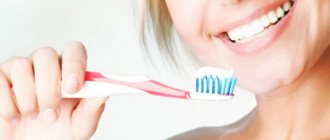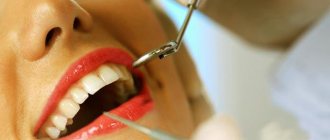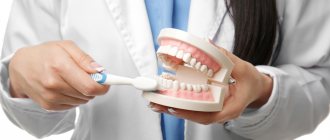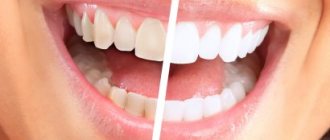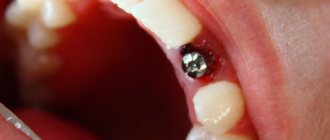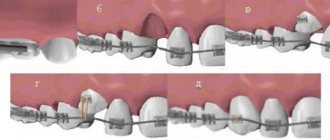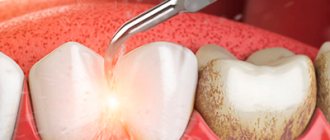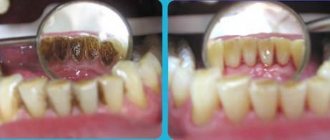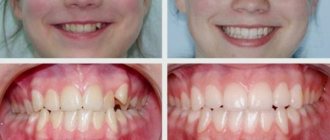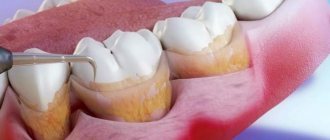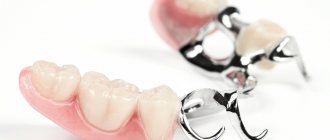Content:
- Fluoride varnish
- Why use a fluoride-based protectant?
- Contraindications to the use of fluorine-containing varnishes
- Is it possible to use varnish at home?
- Carrying out the procedure in a dental clinic
- Important nuances
Enamel is the hardest tissue of the human body, but even it becomes thinner over time under the influence of a huge number of different factors.
The procedure of protective coating of teeth with a special varnish allows you to protect the outer shell of the unit and make it more durable. In addition, dental compounds used to treat the teeth of children and adults are a kind of antiseptics. They block the spread of pathogens and thus provide reliable caries prevention.
Most often, when providing a protective coating for teeth, dentists use fluoride varnish. This is a special viscous liquid, including fluorine and other related compounds.
Not early, but just right
The foundation for a child’s future dental health can be laid already in the perinatal period. It is important that the mother takes a balanced multivitamin during pregnancy. This will definitely help the formation of teeth rudiments in the baby. It is also important for the expectant mother to take care of her own health: prevent diseases, eat right, avoiding sweets and refined foods, and take medications only as prescribed by the doctor. The fact is that a number of drugs have a negative effect on the formation of teeth, as a result they can begin to erupt with defects, stains on the enamel of a darker color (for example, “tetracycline teeth”).
Babies develop their first teeth by the age of one year. However, some babies become toothies even earlier, at 4 months. The enamel layer of the first teeth is thin, the dental and gum tissue is loose, and there are a lot of blood vessels in it. Therefore, the process of teething often becomes extremely painful for children (and unforgettable for parents). To relieve pain, it is recommended to use children's pain-relieving gels and anti-inflammatory drugs, and for hygiene, use special brushes that fit on an adult's finger and special 0+ toothpastes.
Teeth are cutting. What problems await parents Read more
Fluoride varnish
The composition of the varnish, which protects tooth enamel and prevents calcium leaching, includes:
- sodium fluoride;
- shellac;
- fir balsam;
- chloroform;
- ethyl alcohol, etc.
All these substances act in synergy - they provide high-quality disinfection of the treated surface and effectively strengthen it. When enamel comes into contact with sodium fluoride, a hard protective layer is formed. It is thanks to him that the unit ceases to be overly sensitive to salty, spicy and sour foods, and temperature changes.
The mixture has a positive effect on the condition of the gums. After its use, soft tissues become less inflamed and bleed less.
Caries at 2 years old?
By the age of two, most children have most of their teeth present. Alas, the first signs of their carious and non-carious lesions appear precisely at this time, so parents need to carefully monitor this and, if stains appear on their teeth, immediately consult a dentist. And not only for the sake of the child’s future beautiful smile, but in the name of his health. The rapid growth process and rapid blood supply lead to the fact that if any infection appears in the body, it instantly spreads. For example, caries may be to blame for chronic tonsillitis and constant sore throats in a child.
A procedure such as remineralization—saturation of tooth enamel with mineral components (calcium, fluoride)—helps prevent the development of caries deep into the tooth and restore the protective properties of the enamel. Such non-invasive preventive therapy, by the way, is also in demand among adults.
Tooth decay is just around the corner. 7 unforgivable mistakes in dental care Read more
Why use a fluoride-based protectant?
Fluoridation is prescribed to young children to avoid tooth decay. After all, it is very important to keep the milk units healthy until they are replaced. How many years the molars will last largely depends on their condition.
Other indications for enamel coating include:
- Restoration of the natural mineral structure of hard tissues. Fluorine is able to “pull” the necessary minerals from saliva, due to which an active saturation reaction occurs.
- Prevention of premature crown wear. If the tooth is healthy, the problem of abrasion will not arise, so you need to monitor the condition of its tissues.
- High sensitivity. It can be hereditary or provoked by rough mechanical influences performed by dental procedures (for example, whitening).
- Wedge-shaped defect. With this diagnosis, tissue is destroyed in the cervical area. Moreover, the destructive process is in no way related to caries.
It is advisable to cover your teeth with a protective coating after professional ultrasonic cleaning. In general, this procedure will be useful to almost all patients of the dental clinic (with the exception of those who have contraindications to its implementation).
What are fissures and what are they?
Each child's grooves in their molars have an individual shape. To determine whether they need to be sealed, the dentist must carefully consider factors such as:
- recess shape;
- width;
- location on the chewing surface;
- accessibility for hygienic care.
The main feature by which classification is carried out is the shape of the recess. There are four main types of fissures:
Funnel-shaped.
Shallow and fairly wide grooves with good access for toothbrush bristles. In this case, it is not necessary to seal fissures in children; the main thing is to always brush your teeth well. This is the most common type, statistically occurring in approximately 40% of cases.
Cone-shaped.
Relatively shallow fissures, tapering at the bottom. Requires more careful hygiene. Prevalence – 20-25%.
Drop-shaped (ampoule).
These recesses are wide at the bottom but narrow at the top. Full hygienic care is not possible, so sealing is recommended. Prevalence – 20-25%;
Polypoid.
Deep fissures of complex shape. Maintenance is also impossible, so in this case, fissure sealing in children is also mandatory. Prevalence is about 15%.
The first and second types are of the open type, the third and fourth are of the closed type. With good hygienic care, open grooves are kept clean and well washed with saliva. In closed ones, even after thorough cleaning, food particles and bacteria remain. And enamel, due to poor washing with saliva, is characterized by hypomineralization (insufficient saturation with minerals).
Is it possible to use varnish at home?
It is allowed to carry out a strengthening procedure at home, but you should still consult a doctor first. Difficulties will arise already at the stage of purchasing varnish - you won’t be able to find a high-quality and safe solution on the open market. It must be ordered from a dental center or specialized medical store.
If you do find a drug and the dentist allows you to use it yourself, do not forget about the rules:
- pre-dry your teeth using cotton swabs;
- apply the product in a very thin layer;
- The varnish should dry naturally for about 5 minutes;
- Do not eat anything for twelve hours after the procedure.
It hasn't started yet
By the age of three, children have a full set of 20 baby teeth. And all kinds of sweets begin to appear in the children's diet, which provokes the appearance of the first “holes” (cavities) in the teeth. Doctors today are trying to treat such caries using innovative technologies without preparation (without using a drill), which creates the most comfortable conditions for children.
Among the popular methods:
ICON is a new, safe technology for the treatment of caries at the initial stage without preparation. Hard tooth tissues are treated with a specially developed chemical preparation, which, entering the capillaries of enamel and dentin, prevents the spread of caries.
Ozonation is a method of treating caries of primary teeth using ozone. It is considered the most reliable and effective way to protect children's teeth from decay. This painless method allows you to disinfect affected tissues using ozone molecules and destroy all cariogenic microorganisms in the diseased tooth.
Professional mechanical teeth cleaning Air Flow (air-kinetic treatment) is a silent process of non-contact treatment of carious cavities using air flow. The surface of the teeth is treated under pressure with an aerosol jet that contains water, air and abrasive powder based on sodium bicarbonate (soda), after which the tooth enamel is fluoridated.
Avoid losses. What dental diseases are important to cure immediately? Read more
Carrying out the procedure in a dental clinic
Dental treatment in a dental clinic is much more effective than at home.
Before proceeding with the manipulation, the doctor carefully cleans the dental crowns from hard stone and soft plaque. Due to this, the fluoridated gel adheres better to the enamel and penetrates into its deeper layers. Afterwards, the work area is isolated from saliva. This is very important and a person is not able to do this on his own. The dentist then uses fluoride varnish. He carefully distributes it over all surfaces, making sure that not a single area is left untouched. Until the solution dries, the person sits with his mouth open.
An experienced dentist knows exactly how much varnish to use and how to apply it correctly. Therefore, the patient does not risk anything. He can be confident in the effectiveness of the therapy.
How is fissure sealing performed?
There are invasive and non-invasive fissure sealing options. The choice of one or another technique is made by the doctor based on the results of a visual examination, probing of the fissure, sometimes even taking into account additional diagnostic methods, for example, radiography.
Non-invasive sealing technique –
A non-invasive technique is used to seal medium or deep open fissures. The open type of fissures means that they are completely accessible for visual inspection (after all, only this guarantees that the doctor will not miss caries in the area of the bottom or walls of the fissure). A drill is not used to expand fissures here.
Non-invasive fissure sealing: Before and After photos
The main stages of this technique are (a detailed description of what is happening in the photo is located under the photos)
Description of non-invasive sealing - first, the surfaces of the teeth are thoroughly cleaned using a polishing brush and paste (Fig. 5). Further actions depend on the choice of material for filling the fissure. If glass ionomer cement is used, then after cleaning the tooth this cement is immediately introduced into the fissures.
If a composite material is selected, the surface of the fissures is first etched with orthophosphoric acid (Fig. 6), which is then washed off and the tooth is dried. Only after this, a composite material, for example, light-curing, is introduced into the fissures (Fig. 8-9), after which the material is illuminated with a polymerization lamp (Fig. 10). After the material hardens, the chewing surface of the tooth is polished.
Non-invasive sealing of teeth in children: video
Invasive fissure sealing –
It is used in the presence of deep and narrow fissures, the bottom and walls of which cannot be subjected to visual inspection. In this case, it becomes impossible to guarantee the absence of foci of carious lesions in the area of the bottom and walls of the fissures. In addition, in the presence of deep narrow fissures, it is extremely difficult to achieve good filling of the fissure with filling material.
Expansion of fissures with a drill during invasive sealing –
Unlike non-invasive techniques, invasive fissure sealing involves expanding the fissures with a drill. In Fig. 11 you can see a section of a tooth, which schematically shows how the fissure is expanded with the help of a bur (within the thickness of the enamel). In Fig. 12 you can see that the deep narrow fissures were expanded using a drill (they are indicated by arrows), after which they were filled with composite material (Fig. 13).
Video of fissure treatment with a drill –
Important nuances
In order for the use of a fluoride-containing product to be effective, it is important to remember some points:
- After manipulation, it is prohibited to use pastes containing fluoride. This leads to an excess of the component in the body and causes the development of fluorosis.
- Treatment can only be carried out according to medical prescription. Between procedures, intervals determined by the dentist on an individual basis should be maintained.
- Pregnant women are recommended to strengthen their enamel with fluoride. During this period, calcium is actively washed out of the expectant mother’s body. To keep it in your teeth, you need to coat them with varnish. But in case of severe toxicosis, fluoridation is strictly contraindicated.
- Fluoride varnish should be applied after removing braces, during breastfeeding, and after gum disease.
The manipulation can be performed for the first time when the child turns two years old. Then it is done according to indications. Adults should use a fluoride-containing composition at least once a year, immediately after professional oral hygiene.
Dental prevention in children
Healthy teeth are an integral part of a child’s carefree childhood. Proper care, absence of caries and other diseases guarantees oral health. Therefore, it is necessary to carry out timely dental prophylaxis in children.
What can happen to children's teeth?
Children can be classified as a special group of patients. In pediatric dentistry they are always at risk. After all, their body is just learning to work. All protective mechanisms are not yet perfect, and the immune system reacts quite violently to aggressive external influences.
The following factors will contribute to the even greater development of caries, as well as its spread and complications: thin enamel, imperfect immunity, only partial mineralization of teeth, and the anatomical and physiological characteristics of the child.
Caries is one of the sources of chronic infections. It can be the cause of many somatic pathologies. Such as diseases of the gastrointestinal tract, kidney diseases, etc. And caries can also cause complications and even threaten the health of children, not to mention various malocclusion pathologies.
Malocclusion can cause children to become isolated in society, withdrawn, and perform poorly at school. Everything in our body is certainly interconnected. Therefore, it is important to start oral hygiene in children on time and visit the dentist on time.
Caries and malocclusion are some of the consequences of poor dental care
It is possible to prevent caries in a child already during pregnancy and breastfeeding.
At the planning stage of pregnancy, a woman needs to ensure that her body is filled with the necessary vitamins and microelements for the full development of the child. Carry out a complete sanitation of the oral cavity, because caries is a breeding ground for infections, and the formation of organs, including teeth, occurs already in the seventh week of pregnancy. And already at the end of the first half, the baby’s teeth begin to materialize.
Doctors also recommend taking tablets that contain only 1 mg of fluoride. This allows you to achieve two effects at once: the fetus develops strong teeth, and the woman does not wash out fluoride from the body, which ensures that health is maintained at the proper level. Also, do not forget about calcium, which both the unborn child and the mother herself need.
Another important factor in the formation of healthy teeth in a baby is the mother’s regular visits to the dental office. The child takes all the missing “building materials” for his body from the woman’s reserves. And this, in turn, can lead to a lack of vitamins and microelements, and therefore can cause caries, its complications and other diseases of the oral cavity.
A balanced diet will help stop the occurrence of caries and other diseases.
When preventing caries of primary teeth in children, it is important to provide adequate nutrition. Your child's diet should include calcium from dairy products. For better absorption of calcium, vitamin D is also necessary, which can be obtained from fish or exposure to sunlight. Therefore, take your child for walks in the fresh air more often - this helps strengthen the child’s teeth and immunity.
As your child grows, adjust his diet. Dentists recommend excluding some dishes altogether, while adding others, on the contrary. Here are some foods that are considered harmful not only to a child’s teeth, but also to an adult’s:
- Any chocolate products;
- sweets, pastries and cakes;
- fruits with high acidity;
- sweet carbonated drinks;
- concentrated juices, as well as homemade compote, due to their high sugar content.
These products also harm the gastrointestinal tract, causing an imbalance in the acid-base balance. But they can be replaced with more useful ones to avoid dental problems:
- Green tea. It contains natural antioxidants, which slows down the process of caries formation;
- lime. Even though it's citrus. It is rich in fluoride and calcium;
- carrot. This vegetable is rich in vitamins, and its dense structure allows you to cleanse your teeth of plaque.
Dentists also have their own opinion about snacks between main meals. They carry a fairly large factor in the development of caries in children, because they do not allow the acid balance to be restored. Therefore, give preference to solid foods such as apples, carrots, and pears. They do the best job of removing plaque that forms on teeth throughout the day.
It is necessary to practice oral hygiene when a child’s first tooth appears.
It is advisable for the baby to wipe his teeth with a soft cloth or gauze after eating and before going to bed in the direction: from the edge of the gums to the surface of the teeth. As the child gets used to this procedure, a toothbrush with soft bristles and a small head should be used. To prevent baby teeth, it is also recommended to use special wipes with xylitol, which provide protection against microbes.
Dentists also recommend using toothpastes containing fluoride. Such pastes are especially necessary for children with an increased risk of caries. Until the age of 12, parents must supervise the cleaning process. You should not allow your child to swallow fluoride toothpaste. As your baby gets older, you can choose toothpaste with a higher concentration of fluoride.
Always pay attention to the composition of the toothpaste, its quality and purpose. Give preference to those that contain calcium, fluorine, phosphorus to strengthen the enamel, and also correspond to the child’s age.
The next step on the path to healthy teeth is brushing.
It is very important to instill in your child the habit of brushing their teeth every day. This way he realizes the importance of hygiene much earlier. And he will learn to take responsibility for his dental health.
To make the brushing process enjoyable, you need to choose the right toothbrush. At a young age, it is better to give preference to soft bristles so as not to damage the delicate mucous membrane of the gums. They are usually sold in stores labeled “soft”. As you get older, you can switch to medium-hard toothbrushes. They will provide a more thorough cleaning of plaque. Brushes are labeled “medium”.
Only with the help of toothpaste and a brush can you achieve almost complete cleansing of stuck food and plaque. But there is one more important point! Brushes need to be changed promptly, approximately once every three months. With prolonged use, bacteria remain and multiply on the bristles, making the cleaning process less effective.
Take your child to the dental office at least three times a year.
Prevention in pediatric dentistry is not complete without an experienced specialist. Therefore, make it a rule to see a dentist. Only through a professional examination can the development of caries and other oral diseases be detected and prevented in the early stages. If your child does develop early caries, he will promptly carry out all the necessary tests and prescribe treatment. Most often, the following procedures are recommended for children.
- Fluoridation
The doctor coats the child’s teeth with a special innovative composition. It saturates the enamel with all the necessary microelements. Thanks to this procedure, the teeth will become more resistant to aggressive external influences.
- Fissure sealing
This method of treatment and prevention is done both for preschool children with baby teeth and for teenagers. It is advisable to do this procedure within a month or a month and a half from the moment the first molars appear. The doctor closes the deep grooves on the chewing surface of the tooth. Thus, it is possible to eliminate the accumulation of pathogenic bacteria in hard-to-reach places. To do this, experts use fluoropolymer sealant that is resistant to saliva, liquids and acids.
Fissure sealing is one of the necessary methods of prevention
At the first stage, the dentist thoroughly cleans the teeth using a professional brush and toothpaste. Then he applies an acidic substance to the grooves of the pits that have formed on the surface of the tooth. After this, a sealant is applied to the tooth, which is distributed by flowing into the micropores of the enamel and hardens firmly under the influence of a special lamp. This sealant not only “seals” the tooth, but also saturates its enamel with magnesium, calcium and fluoride.
As a result of this procedure, after eating, plaque and bacteria will not accumulate on the chewing surface, which destroy the child’s healthy enamel.
Pharmacy medications will also help improve dental health.
Our diet does not always have enough necessary substances and minerals. Therefore, in pediatric dentistry, doctors recommend receiving all the necessary vitamins in concentrated and dosed form. Today on the shelves of pharmacies you can find many different mineral complexes and vitamins. They are divided into different categories: according to composition, age, indication for use, etc.
To maintain dental health, dentists recommend choosing vitamins with high concentrations of calcium, phosphorus and fluorides. Be sure to consult your doctor before purchasing and using any vitamin complex.
Proper brushing techniques will help keep your teeth healthy.
Brushing teeth for children is not much different from for adults. When cleaning the inner and outer surfaces of teeth, the brush should be positioned at an angle of 45 degrees to the tooth. Perform sweeping movements from the gum to the edge of the tooth. This will thoroughly clean the oral cavity of food debris and plaque. Then, when brushing the chewing surface, position the toothbrush horizontally and move it in a circular motion across the entire dentition, top and bottom.
If you are still not sure how to brush your teeth properly, watch instructional videos. This will make the task much easier.
Brushing children's baby teeth for 2-3 minutes is sufficient. However, this is the norm for an adult. So please be patient while cleaning. If it is difficult for your child to withstand such a procedure, try to turn cleaning into a game, because simple persuasion, as practice shows, does not always help.
Already during the first brushing of teeth, tell your child how useful this procedure is for him. If the child’s fear and reluctance do not go away, then you can watch special educational and preventive pictures that are specially created for children. The sooner you start brushing your teeth with your child, the sooner he will begin to do it on his own. And even more quickly brushing teeth will become a daily habit.
Don’t forget about general hygiene procedures.
High-quality cleaning of the tooth surface and interdental space is unthinkable without additional hygiene, which you need to know about. To do this you need:
- After every meal, rinse your mouth. It is advisable to use special antiseptic solutions for this, which can be found in any pharmacy, or products containing useful microelements. But if for some reason it is not possible to use such products, then ordinary water will do;
- use floss and dental floss. They help clean the spaces between teeth more thoroughly. Such threads are round and flat. It is advisable for children to choose flat flosses in order to avoid wounds on the gums. It is necessary to floss in the presence of an adult, otherwise the child may harm his teeth;
- buy an irrigator. This device is designed for high-quality teeth cleaning at a professional level. Doctors use this not only in pediatric dentistry, but also in adult dentistry. But you can also use it at home if you familiarize yourself with its effects in advance. Here is the main purpose of the irrigator:
- It provides the most effective oral hygiene at home;
- helps prevent the development of other diseases such as periodontitis and gingivitis;
- Suitable for cleaning not only the surface of teeth, but also various artificial structures. It is especially recommended to use this cleaning method when your child has braces or platins;
- prevents the active proliferation of bacteria, and as a result stops carious formations;
- increases blood microcirculation in the gums. The principle of operation of the irrigator is similar to therapeutic massage;
- has a positive effect on the proper functioning of the salivary glands, which again has a beneficial effect on the condition and health of the oral cavity.
Remember that the best treatment in childhood is prevention.
